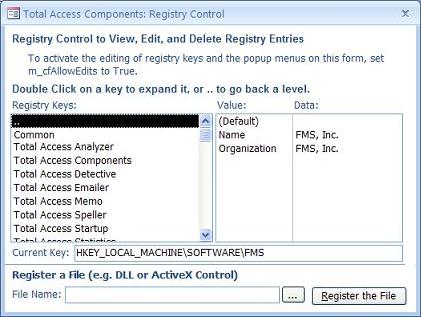Manage the Windows System Registry and Register Objects from Microsoft Access
The Registry control in Total Access Components lets you read and write Windows registry values, and register objects like DLL and ActiveX files to the Windows OLE server.
The Windows registry is a structured database of settings used to store setting and configuration information for Windows and applications. It separates machine and user level information and has security based on your Windows login rights.
Overview of the Windows System Registry
To use the Registry control, you need a basic understanding of the Windows Registry and should be familiar with the Windows REGEDIT.EXE command.
The registry is organized at the top level with root keys. Each of these root keys contains sub-keys, which can themselves contain sub-keys and values. Each value in a key has data associated with it. A value is identified by three pieces of information:
- Root Key:
- HKEY_CLASSES_ROOT
- HKEY_CURRENT_CONFIG
- HKEY_CURRENT_USER
- HKEY_DYN_DATA
- HKEY_LOCAL_MACHINE
- HKEY_PERFORMANCE_DATA
- HKEY_USERS
- Key Name
- Value Name

Using the Registry Control
Place the Registry control on your Microsoft Access form and call its methods (there are no properties for this control).
When you invoke a method, you'll need to specify the Root, Key, and Value names. You can then invoke methods such as:
- GetValueString
- SetKeyValue
- GetKeyValue and GetKeyCount
- GetSubKeyString and SetSubKeyCount
- DeleteKey and DeleteKeyValue
Using the Register Method
The Register method lets you easily register a DLL or ActiveX control by providing the file name. The control automatically updates the registry with the appropriate entries.
Menus
Form Design
Relative Values
Data Entry
Animation
Visual Effects
Windows Dialogs
Multimedia
Supports Microsoft Access 2016, 2013, 2010, 2007, 2003, 2002, and 2000






